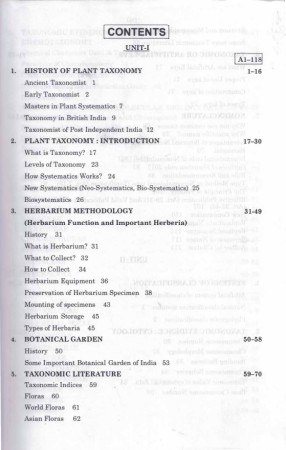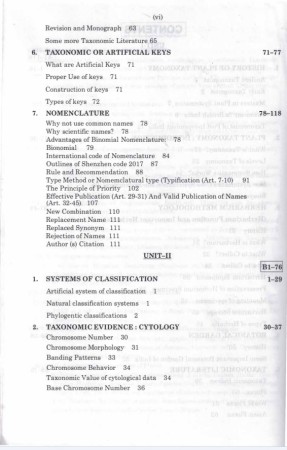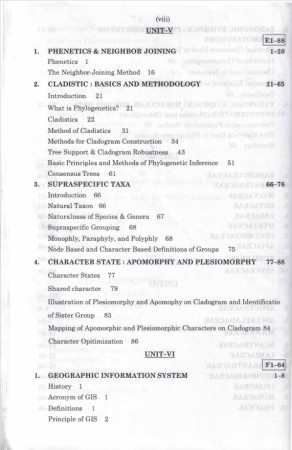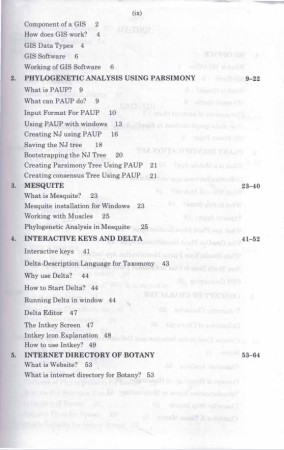











0 Reviews
1451 Views
Taxonomy, one of the oldest dynamic sciences provide thorough knowledge of living species and their various forms. All the branches of botany are depe .... Read More
Price: 480565
You Save 85 15% off
Price: 509565
You Save 57 10% off
*Buy both at: 904 1130
You Save 226
20% off
Taxonomy, one of the oldest dynamic sciences provide thorough knowledge of living species and their various forms. All the branches of botany are dependent on taxonomy, so it may be called as mother of botany. The botanical term "Angiosperm", (Greek angio, vessel+ sperm, seed; i.e., seeds enclosed by a vessel), was coined by Paul Hermann in 1690. It is a monophyletic group which is also named Angiospermae, Magnoliophyta, or Anthophyta. The Angiosperms, Cycads (Cycadophyta), Conifers (Coniferophyta), Gnetophytes or Gnetales (Gnetophyta) and Ginkgo (Ginkgophyta) are the five major lineages of the extant seed plant. Of these Angiosperms are the most species rich and include more than 13000 genera and 300000 species.
| Sr | Chapter Name | No Of Page |
|---|---|---|
| 1 | UNIT-I, 1. HISTORY OF PLANT TAXONOMY | 16 |
| 2 | 2. PLANT TAXONOMY : INTRODUCTION | 14 |
| 3 | 3. HERBARIUM METHODOLOGY (Herbarium Function and Important Herberia) | 19 |
| 4 | 4. BOTANICAL GARDEN | 9 |
| 5 | 5. TAXONOMIC LITERATURE | 12 |
| 6 | 6. TAXONOMIC OR ARTIFICIAL KEYS | 7 |
| 7 | 7. NOMENCLATURE | 41 |
| 8 | UNIT-II, 1. SYSTEMS OF CLASSIFICATION | 32 |
| 9 | 2. TAXONOMIC EVIDENCE : CYTOLOGY | 9 |
| 10 | 3. TAXONOMIC EVIDENCE : PHYTOCHEMISTRY OR CHEMOTAXONOMY | 20 |
| 11 | 4. TAXONOMIC EVIDENCE : MOLECULAR BIOLOGY DATA IN SYSTEMATICS (Nucleus and Chloroplast) | 18 |
| 12 | UNIT-III, 1. RANUNCULACEAE | 5 |
| 13 | 2. PAPAVERACEAE | 5 |
| 14 | 3. MALVACEAE | 6 |
| 15 | 4. RUTACEAE | 7 |
| 16 | 5. FABACEAE | 11 |
| 17 | 6. MYRTACEAE | 6 |
| 18 | 7. CUCURBITACEAE | 7 |
| 19 | 8. APIACEAE | 8 |
| 20 | 9. RUBIACEAE | 7 |
| 21 | 10. ASTERACEAE | 8 |
| 22 | UNIT-IV, 1. APOCYNACEAE | 6 |
| 23 | 2. ASCLEPLADACEAE | 8 |
| 24 | 3. SOLANACEAE | 7 |
| 25 | 4. ACANTHACEAE | 5 |
| 26 | 5. LAMIACEAE | 8 |
| 27 | 6. AMARANTHACEAE | 5 |
| 28 | 7. EUPHORBIACEAE | 7 |
| 29 | 8. LILIACEAE | 7 |
| 30 | 9. MUSACEAE | 5 |
| 31 | 10. POACEAE | 8 |
| 32 | UNIT-V, 1. PHENETICS & NEIGHBOR JOINING | 20 |
| 33 | 2. CLADISTIC : BASICS AND METHODOLOGY | 46 |
| 34 | 3. SUPRASPECIFIC TAXA | 12 |
| 35 | 4. CHARACTER STATE : APOMORPHY AND PLESIOMORPHY | 15 |
| 36 | UNIT-VI, 1. GEOGRAPHIC INFORMATION SYSTEM | 8 |
| 37 | 2. PHYLOGENETIC ANALYSIS USING PARSIMONY | 14 |
| 38 | 3. MESQUITE | 18 |
| 39 | 4. INTERACTIVE KEYS AND DELTA | 12 |
| 40 | 5. INTERNET DIRECTORY OF BOTANY | 12 |
| 41 | UNIT-VII, 1. MS OFFICE | 18 |
| 42 | 2. PLANT IDENTIFICATION APP | 10 |
| 43 | 3. CONCEPT OF CHARACTER | 32 |
| 44 | UNIT-VIII, 1. GARDENING SYTYLE & AESTHETIC | 8 |
| 45 | 2. FEATURES OF GARDEN | 10 |
| 46 | 3. GREEN HOUSE | 6 |
| 47 | 4. BONSAI | 6 |
| 48 | 5. SPECIAL TYPES OF GA RDEN | 11 |
| 49 | 6. TREES AND SHRUBS FOR GARDENING | 11 |